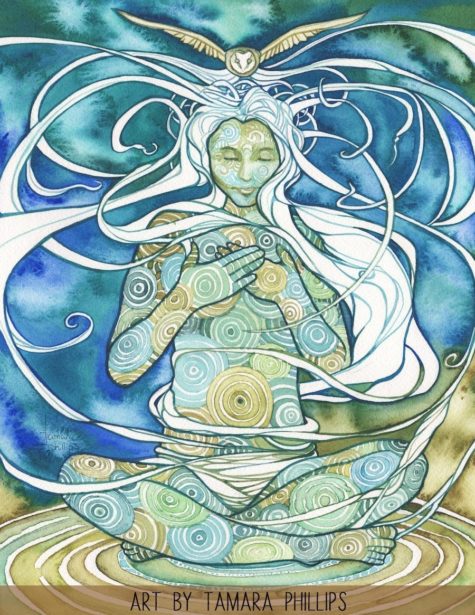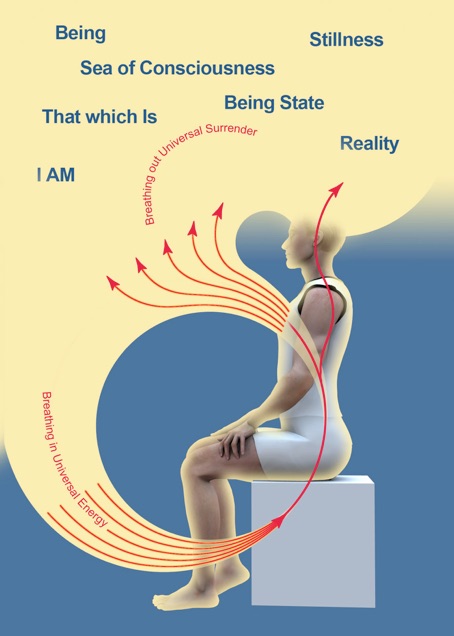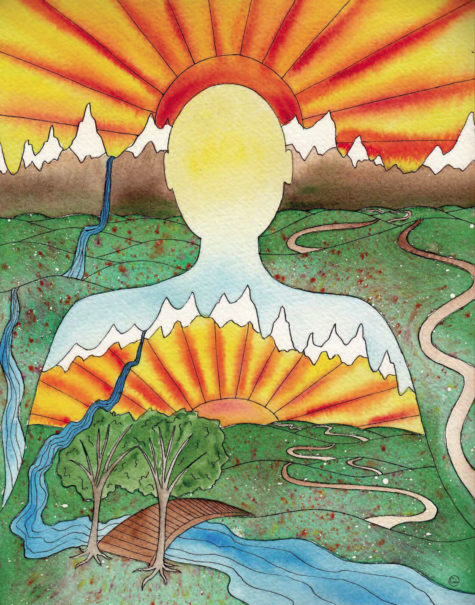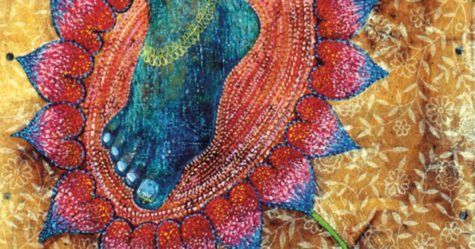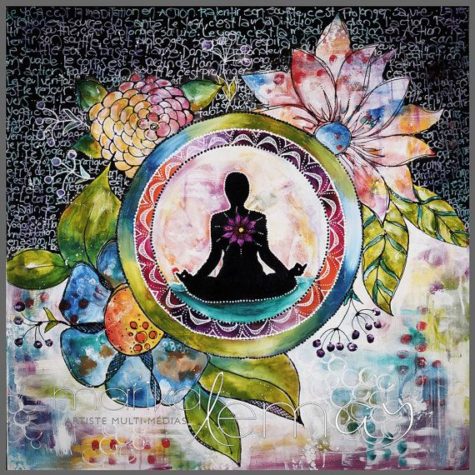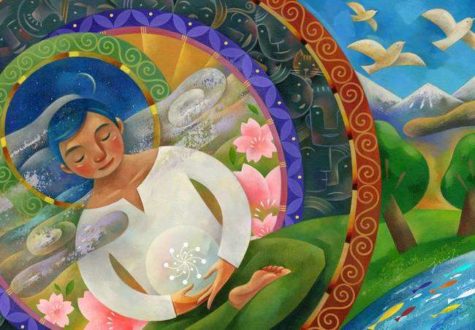Mindfulness Meditations
With every breath we take, nature is potentially providing us with an opportunity of shifting our consciousness and entering an enlightened state. The reason this gateway to the greater reality remains firmly shut for most of us is that we don’t give it our attention. We are much more committed to following the commands of our inner commentator with its incessant stream of thoughts over which we have little control.
If we get into the habit of using our breath as a means of focusing attention away from our thoughts to our feelings, we would gradually obtain sovereignty over our mind and liberate ourselves from the compulsions and addictions of habitual and often idle thought. Above all, instead of debating good and bad, pros and cons in our thoughts, we open an instant highway to the spontaneous wisdom of the heart.
It is the decision making process more than anything else that will train our mind to embrace Stillness instead of continuing to endure the constant inner chatter and uncontrolled commentary of our thoughts. By deciding to favor our breathing with our attention, rather than our inner chatter, we are gradually training our minds to embrace a greater reality. From then on our thoughts will become our tools and instruments rather than our masters.
The best way to deprive our thoughts of their compulsive nutrition is by using a different mode of thinking and perception. Instead of seeing with your eyes which is then narrated and judged by our mind and our old ideas, we learn to see with your heart, without judgement or interpretation. Using the same process when speaking and hearing will make a difference to the quality of our communication.
This new mode of gathering information or communicating will connect us to a higher level of reality. It will also open the channels of intuition, which is basically a much more evolved form of thinking as it encompasses information we are consciously unaware of.
This new mode of operating our senses can be learned like any other skill. We will know when we are successful when our stream of thoughts becomes quiet and everything becomes still around us. Our thoughts are no longer in the driving seat and instead of continuous judgement, which takes all our energy and deprives us our objectivity, we become aware of a powerful feeling of compassion, love and connectedness to all life. Our ego identifications become less important as we begin to identify with the the space surrounding us rather than the voices in hour head. We access reality directly rather than our interpretation of it and gain a much more inclusive understanding of who we are.
The best way to practice this kind of Seeing and Thinking with our Heart is by connecting our feeling to our breathing. As we breathe constantly anyway, we can practice this technique all day long. Instead of following our thoughts we simply decide to follow our breathing. We do this breathing in the awareness of the energy and the stillness surrounding us through the base of our body.(see diagram) We then follow our breath as it reaches our heart. We then surrender our breath again to the Stillness of the greater consciousness surrounding us, the same space of consciousness where we have taken it from.
The surrender of our breath or outbreath is accompanied by a feeling of goodwill or love. With this feeling of love we also automatically surrender the idea of our limited ego identification without even thinking about it. Instead we take comfort in the fact that we offer everything we are to a greater reality and the much larger reality of our true being.
This is the Anytime Anywhere Meditation because we can do it anytime and anywhere, whilst washing, having breakfast, driving to work, in the office, at lunch, in the cinema, talking to friends or operating machinery because it is a feeling rather than a conscious thought process. We favor surrender rather than clinging to our thoughts and judgments. Gradually our thoughts will learn to follow the wisdom that rises from the heart rather than insist on its old prejudicial pattern. As our thinking becomes more clear and we become in tune with reality our actions will be guided by the rise of wisdom, and we will use our mind as an instrument.
Source: Multidimensional Man
This is a transcript of an interview with author Jurgen Ziewe about The Ten Minute Moment by Evita Ochel. I found it interesting and informative, and so am sharing it here:
- Evita:
Your book The Ten Minute Moment shares your personal journey of a solitary meditation retreat in a remote log cabin in the mountains of Scotland. What is the greatest impact that this experience had on you, as you see it today?
- Jurgen:
The profound experience mentioned in the book formed a tipping point, which turned out to be irreversible. There is no going back. Now everything existing in the present moment is of equal importance, because every appearance is supported by the all pervading reality of stillness and unity. There is no getting away from the fact that all reality — and no matter how this reality presents itself in my daily life — is underpinned by pervading stillness against which everything else plays out, which of course is always transient.
I discovered I could no longer ignore or turn my back to this resilient fact. The reality of it is just too overpowering, too obvious. I only have to look at anything, any object at all, to find proof of it, to see this unity. Everything that exists, simply by my awareness of it, convinces me of this profound fact. I knew, that from this moment onwards, this stillness and profound peace was against which everything else had to be evaluated and considered.
- Evita:
Given your vast experiences with meditation over the years, how would you describe what meditation is?
- Jurgen:
To me meditation is simply accepting that I am already one with all. Meditation is the surrendered resting in this overwhelming fact. So I don’t have to do anything special, just accept this reality. With this acceptance comes the security that I do not need to go anywhere or aim for anything. I simply surrender to its fulfillment. Knowing that I am already here, united with my source I simply rest in and relish the reality of it. There is nowhere else to go. I am already where I am meant to be. To me that is meditation.
However, should I consider a traditional meditation technique when resting in my chair, such as focusing on the light or a mantra, I then simply take the position of the light and rather than focusing on it, I radiate out from it into the universe surrounding me, because I am already the light or the mantra.
- Evita:
There are many types of meditation talked about in our society and beginners are often confused about what kind of meditation to do. What is your recommendation in this regard?
- Jurgen:
To me Meditation is an individual contract each one of us makes with their own source, God or their Higher Self; a contract which is simply based on love. I realize that some people may take a different route, and that is why I think it has to be an individual path. With billions of people there are billions of meditation techniques. The good news is that the moment I direct my attention within, I develop more of a sense of what is good for me and what is not. To me, the meditation is to find the best way to open a channel of communication to the inner teacher.
- Evita:
Many people who attempt meditation are often also frustrated by the constant chatter of thoughts expressed by the mind, which they cannot seem to turn off or escape from. What is your advice on how to overcome this?
- Jurgen:
Show kindness to your thoughts. When kindness and love rise in your awareness these feelings are more powerful than thoughts. Giving preference to appreciation, gratitude and love makes meditation and the focus much easier, more pleasurable and more rewarding. I see thoughts like boats on the ocean, where the ocean is love. When love becomes the carrier of my meditation then my thoughts become like sailing boats on the ocean’s surface, submitting to the carrying elements. If the ocean is calm my thoughts are calm and pacified, and my meditation will be enjoyable.
But sometimes thoughts come along which need attention. Some thoughts are not really worthwhile and I simply let them wither by not paying them any attention. Others are powerful and crave for every ounce of awareness I can give. Their challenge makes me dig deep until I reach the level of wisdom. So sometimes these big compelling thoughts can lead me to a much deeper level of awareness. I know when I have reached this level because it is like a crystal lake of reflection, with its mirror surface it reflects my thought from all sides. I use kindness and understanding in my reflection and never condemn. I let no aspect be unattended to or rejected, and show all of its aspects the greatest respect. Because, deep down I know I am the parent of my thoughts, which I recognize as my own children. Like a good father I guide my thoughts into the clear light of understanding, then peace will result or a clear plan of action will emerge.
Then there are thoughts that are like warm honey from a flower of wisdom and knowing deep within. They are the gift of inspiration which are offered to enrich my life and the lives of others. I show my gratitude to these offerings and store them in my soul for later use.
Then there can be habitual or addictive thoughts trying to steal my attention, I simply stop feeding these until they wither and instead favour the reality of ‘what is’ and the unspoken moment which doesn’t require thought. If I do not succeed I simply rest my awareness on my breath or any other feeling I can devote my love to until I find rest and calm awareness.
- Evita:
Intentional silence, solitude and stillness to experience pure being have become increasingly rare in our world today. Why are these experiences important to prioritize and cultivate in our lives?
- Jurgen:
Real silence, solitude and stillness are only found once the self referential chatter of our mind has stopped. The mind is a Perpetuum Mobile, always feeding and needing to be fed, always striving for answers while continually remaining unsatisfied. We may turn to solitude in nature and yet the mind may be churning out its constant chatter. Real solitude is to be found when this chatter is disrupted by something that takes our attention into a completely new direction, which is inaccessible to the mind. This is actual experience, which enriches the heart and our feeling.
Instead of channeling our input through our senses via the mind, we channel our input through the heart. Instead of hearing and seeing the bird in the tree, we identify with and ‘become’ the bird in the tree by sending it our love and experience its existence. After all, in reality, consciousness is not limited to our own body and self, but it is everywhere we look at and place our attention on. The moment our attention is placed on the all surrounding ‘us’ we experience true silence and stillness because there is no longer anything the limited mind can divide us from. There is only the experience of pure being.
Sometimes we need to create space in our lives to disrupt the constant flow and feedback of information. To be alone with our thoughts and our self is just as important for our mind and soul, as a good diet and exercise is for our body. Daily, regular meditation can give us this space even in the busiest metropolis and provides the nourishment for our soul.
- Evita:
At the end of the book you share 12 markers of an awakened life that you noticed have manifested in your life. Which one, would you say, has been the most instrumental in changing who you are and how you live your life today, and why?
- Jurgen:
Number two. The constant feeling of being home. This is the most persistent experience because there is no longer such a thing as an outside world. I am always home wherever I am, even in the biting cold of the winter storm, because that too is the experience of what I am. Wherever I want to be I am already here and that fills me with great peace and satisfaction. My greatest joy is the constant experience that I am Here, that I have been chosen and blessed simply to be alive.
- Evita:
What do you see today, as the greatest obstacle that humans of this Earth reality face to advance their spiritual evolution, and what can be done about this?
- Jurgen:
Reality is simple, it’s just that we are so engrossed in our mental interpretation of it that we have lost our natural means of communication with that which simply is. Present reality is the great leveler, there for all, from insect to human, and we don’t need the mind to access it. We simply need to be and live in the acceptance of our being. The most natural way to do so is to surrender to it without thinking about it. The moment we surrender, reality makes us a conscious part of its universal being and bliss.
How do we surrender when we are so accustomed to and in need of control, when our first line of confronting a situation is via our emotions, instincts, and conditioned behavior?
The first action would be to surrender to any given situation via our heart first, by accepting it, appreciating the presence of its reality. Accepting here-now reality and the way it presents itself by sidestepping the ego creates space for intuition to come to the fore and guide our interaction. Acceptance creates space and makes it apparent that we are an intrinsic part of the challenge. This offers us a greater view of the situation from within and we are able to appreciate the position of others. Instead of controlling a situation on a whim we are adapting to its inherent nature, which is not blindsided by self interests. We derive strength and power from an underlying current of what is right and true, which will give us the authority and strength to act in harmony with its inherent laws and make our decisions with clarity.
When we wake up to this simple and amazing fact that stillness underpins all reality and gently and with kindness go about our daily business, we calmly take stock and begin to understand what needs to be done. We begin to see that that which we think is us, is in fact only a minuscule part of the whole. Instead of seeing the world only in relation and separation to ourselves, we begin to experience the world around us as a whole and as our home. Once this realization manifests in our daily life, we begin to act in a way which benefits the whole. By asking “how can I serve?” we benefit ourselves because we are part of the vast reservoir we are serving.
- Evita:
Thank you so much Jurgen for sharing your time, love and wisdom with us here today. Your message is always shared with such an immense amount of gentleness and compassion, yet it guides us to the core of truth like a laser, with utmost focus and clarity.
Here is an excerpt from an interview with Jurgen Ziewe, in which he talks about meditation. I found it interesting and helpful, so am sharing this here:
- Question:
Meditation can mean different things to different people, so what is your exact definition of “meditating”?
- Answer:
To me meditation means living in the present or as Eckhard Tolle says, “living in the now”. Meditation begins by forming a habit that allows you to put yourself in control of your thoughts, which means if you focus during meditation on the light, a mantra or anything else and thoughts pop up you simply say, “OK, now lets go back to the focus” without any force whatsoever.
It is the continuous “OK, now lets go back to the focus” which is the most powerful aspect of meditation not necessarily the object of the meditation, such as the light or the mantra and can almost be anything.
What you are doing is conditioning your mind into following your intent. It’s a bit like training a dog. Once you have achieved this you simply focus on consciousness during meditation and during your daily life. You’ll gradually find yourself living more and more in the present or in the “Now”. Your focus becomes much better too as a result and your life more rewarding, blissful even. There is no reason why you cannot meditate whilst out of the body which can have spectacular results.
- Question:
On the topic of meditating, do you know what is an optimal way to become more able at perceiving and expanding with/through the consciousness? I have been attempting for a while to do this, but without much success.
- Answer:
A common misconception is that meditation needs somehow a lot of effort or discipline. Quite frankly, the opposite is the case. It’s more a matter of favoring focus on whatever you are meditating on instead of the thoughts which inevitably arise. Thoughts are OK, as long as they don’t dominate us.
Thoughts can be great fun and we have developed a whole industry creating entertainment for our thoughts. The trick is to be able to decide which thoughts we want or whether we want them at all and instead enjoy the underlying serenity of the present moment without thought distraction.
Meditation to me is habituating the mind so it finally naturally follows our intent. It is not to control our mind or dominate it. As such meditation is a beautiful experience, because we never reject our thoughts we just regard them like our children we love, but who we won’t allow to tyrannise us.
The aim of the meditation should be: “OK, now lets gets get back to our focus”, it is this process which is important not the focus itself such as light, sound or mantra. Once focus follows your intent effortlessly your attention simply lingers quite naturally on reality, the moment, the present, God or whatever you wish to call it.
Once we have freedom from the compulsion of thinking we simply focus our attention on awareness or consciousness itself without any attributes dictated by our thinking or imagination, which means we live in the present and become aware of what makes the present. We live in reality.
- Question:
Many chant different Names of God and mantras. The specific thing they chant does mean something because they are utilizing that specific Name of God/mantra.
- Answer:
There is often a misunderstanding about the use of mantras. Some people think just by chanting and repeating the mantra they are getting closer to the higher consciousness or God. I found this to be an illusion. When seen from a higher level such chants look more like a marble clattering around endlessly in an empty jam jar without ever leaving it’s confines.
Often the chanter even thinks about other things while chanting like some robot or tape recording, clearly without the heart being in any way connected. This is as pointless as planting a crystal in the ground and expecting it to grow into an oak tree.
As pointed out previously the mantra can be a powerful vehicle for transporting consciousness into subliminal levels, but we will have to engage with the mantra. The most effective way is by totally surrendering to or identifying with the mantra. This way the mantra is no longer an object of our meditation but it’s manifestation with which we will have merged.
You may sometimes find yourself longing to sit and do nothing, yet when the opportunity presents itself, you may not know how to enjoy it.
That’s largely because our society is very goal-oriented. We tend to always be going in a certain direction and having a particular aim in mind. Buddhism, on the other hand, has a certain respect for enlightened “aimlessness.” That teaching says you don’t have to put something in front of you and run after it, because everything is already there inside you. The same is true with sitting.
Don’t sit in order to attain a goal. Each moment of sitting meditation brings you back to life. Whatever you are doing, whether it’s watering the garden, brushing your teeth, or doing the dishes, see if you can do it in a way that is “aimless.”
– Thich Nhat Hanh
15 practical steps Thich Nhat Hanh says we can take to bring mindfulness to our work:
- 1. Start your day with 10 minutes of sitting in meditation.
- 2. Take the time to sit down and enjoy eating breakfast at home.
- 3. Remind yourself every day of your gratitude for being alive and having 24 brand-new hours to live.
- 4. Try not to divide your time into “my time” and “work.” All time can be your own time if you stay in the present moment and keep in touch with what’s happening in your body and mind. There’s no reason why your time at work should be any less pleasant than your time anywhere else.
- 5. Resist the urge to make calls on your cell phone while on your way to and from work, or on your way to appointments. Allow yourself this time to just be with yourself, with nature and with the world around you.
- 6. Arrange a breathing area at work where you can go to calm down, stop and have a rest. Take regular breathing breaks to come back to your body and to bring your thoughts back to the present.
- 7. At lunchtime, eat only your food and not your fears or worries. Don’t eat lunch at your desk. Change environments. Go for a walk.
- 8. Make a ritual out of drinking your tea. Stop work and look deeply into your tea to see everything that went into making it: the clouds and the rain, the tea plantations and the workers harvesting the tea.
- 9. Before going to a meeting, visualize someone very peaceful, mindful and skillful being with you. Take refuge in this person to help stay calm and peaceful.
- 10. If you feel anger or irritation, refrain from saying or doing anything straight away. Come back to your breathing and follow your in- and out-breath until you’ve calmed down.
- 11. Practice looking at your boss, your superiors, your colleagues or your subordinates as your allies and not as your enemies. Recognize that working collaboratively brings more satisfaction and joy than working alone. Know that the success and happiness of everyone is your own success.
- 12. Express your gratitude and appreciation to your colleagues regularly for their positive qualities. This will transform the whole work environment, making it much more harmonious and pleasant for everyone.
- 13. Try to relax and restore yourself before going home so you don’t bring accumulated negative energy or frustration home with you.
- 14. Take some time to relax and come back to yourself when you get home before starting on household chores. Recognize that multitasking means you’re never fully present for any one thing. Do one thing at a time and give it your full attention.
- 15. At the end of the day, keep a journal of all the good things that happened in your day. Water your seeds of joy and gratitude regularly so they can grow.
– Thich Nhat Hanh
Meditation is one path to self realization and tranquility. One of the most important meditation techniques is the mindfulness meditation.
Mindfulness is a mental state that enables you to stay with a calm mind. It helps you stay aware of all the physical and mental activities of the present. It is a form of Buddhist meditation that has been practiced for eons. According to Buddha’s noble eight fold path, it is the seventh element. Mindfulness develops wisdom of the human mind.
Insight is another name for mindfulness meditation. This type of meditation helps to concentrate on the present. This technique allows you to let go of the past and future thoughts, hindering a certain peace of mind. During mindfulness meditation, you stay aware of the mind’s thoughts that are going on, and any actions that are happening in the present moment. This meditation technique helps to focus on the real present and develop concentration.
To really understand the meaning of and the benefits of mindfulness meditation you will need to practice it. The basic preparation and guidelines to practice this meditation technique properly is discussed here: Beginning Mindfulness Meditation.
Found at: Meditation Guidance
Here we have basic preparation and guidelines for a beginning practice in mindfulness meditation:
Create a favorable environment. This is one of the most important things to do. Mindfulness for beginners is quite easy, if you take that all important step and get started.
There should not be any sort of distraction in the place that you will select for practicing this meditation technique. This place should be calm and quiet. There should not be any sound or noise to distract you and disturb you during your meditation. This place should be such where you can forget all your pain, sorrow and can get rid of all your stress. This place should emit a sacred feeling. It can be a religious place or any place of your choice which gives you positive vibes. You don’t need to be a practicing Buddhist to see the benefits that come from a mindfulness practice.
Starting your meditation is a rather simple process. It may help to start meditating for just short periods, but do so frequently. Do not sit for long periods of meditation initially. You’ll need to slowly adjust to the meditation techniques for best results. Utilizing a meditation timer is a great way to keep track of time without worrying about a clock.
Having the correct posture is crucial step in mindfulness for beginners. There is a strong connection between the body and the mind. Hence, to control your mind you need to control your physical posture. The right way of meditating is to have an upright erect posture. Think of the traditional cross legged (lotus) pose. Keeping an erect posture helps with concentration, though you should not experience any discomfort. When it comes to meditation for beginners staying focused is one of the biggest hurdles.
Your focus should be down around the few inches around your nose. The eyes can remain open and still not be distracted by your surroundings.
The goal here is to focus on your breath during meditation. Your natural breathing process should be the object of concentration during your meditation. You may focus on your exhale as it passes through the back of your nasal cavity or you can feel the air as it escapes past your nostrils. If you get distracted, that’s okay, just refocus and feel your breath as you come back to the meditation.
Remove your thoughts and focus on the present through your breathing. It may be easier said than done, but this is what we strive for. Initially it will be very difficult to focus and concentrate your mind. You will feel yourself getting distracted by the constant chatter of the mind. By feeling your breath to the core, you can gradually root your mind in the present and stay focused.
These are the very basic fundamentals, as they relate to practicing mindfulness meditation. There are many Buddhist texts and guided meditations that will certainly help advance your practice.
Found at: Meditation Guidance
Night is tremendously beautiful. It is a good time for meditation. It helps you release the tensions of the day easily and effortlessly. This particular meditation will increase your connection to the Magickal Energy inherent in darkness, starlight, and moonlight.
Here’s a very simple, very effective meditation:
Before you go to bed at night, alone or with a partner, sit silently, look into the darkness. Become one with the dark, disappear into it. Look at the stars — feel the distance, the silence, the emptiness, and use night for your meditation.
Sitting on your bed, or on your balcony, or in your garden, doing nothing…just feeling, just being there. The day is worldly, the night is more spiritual. Over time you will feel tremendously in tune with night. The world is asleep. Everything stops, traffic, noises, the mundane world is quiet. People, their unconsciousness, bad attitudes, have all disappeared into sleep. The atmosphere is clean with no jarring note.
Benefits:
As you start enjoying the beauty of the night, you will feel it more and more. As you absorb the tranquility, serenity, and comfort night offers, your sleep will then carry a meditational and in the morning you feel refreshed in a whole new way.
Source: Pragito Dove
A meditative awareness comes like a whisper, not a shout, with noiseless footsteps. If you are full of occupations, busyness and noise it might come and wait, but then it will leave.
Set aside some time — 3, 5, 10, 15 minutes or longer — preferably every day, for sitting in silence. It doesn’t matter where you are, just sit, close your eyes, and wait. Don’t do anything, just sit in great waiting with an open, trusting heart. Then if something is to “happen” you will be ready to receive it. If nothing happens, at least you’ve had this “down time” to do nothing. No matter what, after sitting silently for a while you will feel more in touch with yourself, more peaceful.
When and Where:
Most people find that it works best to do this at the same time every day. It doesn’t matter what time you choose, but setting aside a set time, say as a mid-morning break or during your lunch hour, helps make it part of your daily routine. When the inner consciousness knows that the outer consciousness is waiting for it, there is a greater possibility of a meeting.
Benefits:
As you practice doing nothing, by and by an understanding will start to arise between you and the meditative state. As this understanding grows you will start to feel a subtle quality of relaxation, of serenity woven into the texture of your whole day.
